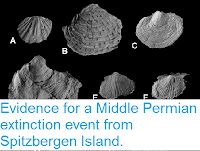The formation of Large Igneous Provinces have been associated with three of the five largest extinction events in the Earth's fossil record, including the most severe of these, the End Permian Extinction, in which it has been estimated 96% of all species then present on Earth were wiped out, and which is generally linked to a release of greenhouse gasses (methane and carbon dioxide) associated with the emplacement of the Siberian Traps Large Igneous Province. However these Large Igneous Provinces typically take several million years to form, while extinction events are thought to happen over only a few thousand years, which implies that the connection between the two events is not simple.
In a paper published in the journal Nature Communications on 31 July 2017, Seth Burgess of the Volcano Science Center of the U.S. Geological Survey, James Muirhead of the Department of Earth Sciences at Syracuse University, and Samuel Bowring of the Earth, Atmospheric, and Planetary Sciences Department at the Massachusetts Institute of Technology, publish a detailed examination of the timelines of both the Siberian Traps vocanic episode and the End Permian Extinction, and make deductions about the conections between these two events.
Burgess et al. used a timeline for the emplacement of the Sibetian Traps Large Igneous Province previously developed by Seth Burgess and Samuel Bowring, and published in a paper in the journal Science Avances in 2015. This timeline divided the formation of the Siberian Traps into three phases, Stage 1, Stage 2 and Stage 3. Stage 1 lasted from 252.24 to 251.907 million years ago, and saw an extensive period of volcanic extrusion, as magma from a plume deep within the Earth's interior burst through the lithosphere and erupted at the surface in a series of vast pyroclastic eruptions. Stage 2 lasted from 251.907 to 251.583 million years ago, and saw a cessation of surface eruptions, which were replaced by the emplacement of extensive volcanic sills (sheets of volcanic rock injected in between older layers of sedimentary rocks) across the Tunguska Basin of Siberia. In Stage 3, which lasted from 251.583 to 250.2 million years ago, this sill emplacement stopped and was replaced by a second phase of eruptive surface volcanism.
Comparing these events to the timescale of the Permian Extinction, Burgess et al. found that Stage 1 of the Siberian Traps vocanism had relatively little impact on either the Permian biosphere or its climate (as determined by carbon isotope ratios in marine sediments), with only limited signs of climatic instability around the poles. However the onset of Stage 2 was associated with both a sudden very sharp change in carbom isotope levels, thought to be indicative of the release of large amounts of greenhouse gasses into the atmosphere and a subsequent rise in ocean temperature of about 10℃, and also the sudden and more-or-less complete collapse of the Earth's biosphere. The remainder of Stage 2 is associated with a smaller, more steady increase in greenhouse gasses, but limited further impact on the biosphere, while Stage 3 was associated with a gradual lowering of greenhouse gas levels.
This implies that the greenhouse gasses associated with the End Permian Extinction were not derived from the magma plume which caused the Siberian Traps volcanism, but rather were released from the sediments of the Tunguska Basin by metamorphic reactions during the emplacement of the sills during Stage 2 of the episode. This was particularly rapid at the onset of this phase, when magma was first passing through the sediments, causing the emission of stored carbon; further emplacement of igneous material had limited effect as the majority of this carbon had already been released.
Time series of Siberian Traps LIP emplacement. (a) Pre-emplacement basin. (b) Emplacement of a volcanic load during Stage 1. The feeder system is unresolved, and most likely situated below lavas in (f). (c) Beginning of Stage 2, with lateral sill complex growth, widespread heating, and greenhouse gas generation. (d) Continued sill emplacement during Stage 2. (e) Renewed extrusive magmatism during Stage 3. Burgess et al. (2017).
See also...
Follow Sciency Thoughts on Facebook.





